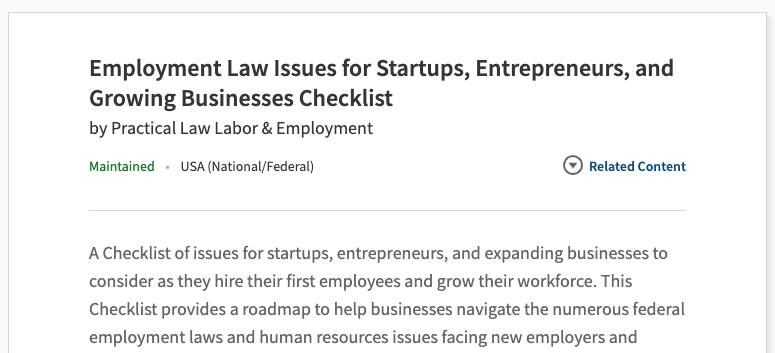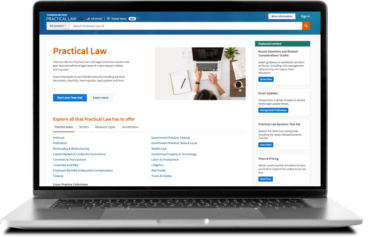An effective employee preboarding and onboarding program helps increase new hires’ job satisfaction, engagement, productivity, and retention.
Employee onboarding is a crucial part of the hiring process. The way a new hire is welcomed sets the stage for future performance, corporate integration, and job satisfaction. During the onboarding process, new hires learn about job responsibilities, corporate procedures, and administrative processes. Successful onboarding helps individuals smoothly transition into new roles and can limit a company’s exposure to potential employment claims.
A methodical onboarding program also helps managers and new hires stay on task. Using a checklist that includes key onboarding events like the first day meet and greet, paperwork completion dates, and a job training schedule helps ensure effective employee onboarding.
While onboarding may seem like a logical first employment step, a process called “preboarding” actually precedes the employee’s first day on the job.
Jump to ↓
| What is employee preboarding? |
| 11 steps to set up an effective employee onboarding process |
| The employee handbook — A key onboarding tool |
| What are signs that employee onboarding was not successful? |
What is employee preboarding?
Preboarding paves the way for the actual onboarding process and can begin months – or days – before an employee’s official start date. The preboarding process includes opportunities for employee meet-and-greets, information sharing discussions, and provides a chance for employees to complete preliminary paperwork. Engaging with new hires early on make them feel welcome and excited about their new roles. Preboarding involves tasks such as:
- Conducting background checks — Background checks should be completed before an offer is extended. These important reviews allow employers to evaluate an individual’s credentials, minimize the risk of employee fraud or theft, minimize workplace violence, and limit litigation exposure.
- Communicating with new employees — Weeks, or even months, can pass between the acceptance of a job offer and an employee’s actual start date. Keeping in touch with new hires during this time maintains the new hire’s feelings of engagement and excitement. Remember, other companies may still be courting the new hire. Don’t let them be the only ones in a future employee’s ear.
- Connecting new hires with their future team members — Beginning a new position is intimidating. Employees who are introduced to their future co-workers feel more at ease when entering a new corporate environment.
- Collecting the signed offer letter — Before an employee’s first day, have them review, approve, sign and return applicable employment agreements. These agreements can include their offer letter, employment agreement or contract, non-disclosure agreement (NDA), and arbitration agreement. There may be other relevant documents depending on the employee’s classification and job responsibilities.
- Sending pre-employment paperwork — While companies can opt to save new hire paperwork requests for the employee onboarding process, there is no harm in getting some of the more mundane administrative tasks out of the way before employment officially begins. Employers can request state and tax forms like W-4 for federal income tax, W-4 for state income tax, Form I-99 for employment eligibility verification, direct deposit forms, distribute the employee handbook (including benefits information), and send company policies.
- Talking to your current team — Bringing in a new employee can make current employees nervous. Explaining the new hire’s role and responsibilities goes a long way to ease current employees’ concerns. You don’t want your existing team to feel threatened by their new co-worker.
- Sending an onboarding schedule — Effective onboarding can take days or months. Setting forth the schedule will help new hires plan accordingly.
If preboarding was effectively executed, new employees are excited and prepared on day one.
 |
11 steps to set up an effective employee onboarding process
Once new hires are cleared for employment and offer letters are signed, the multistep onboarding process begins. Try to complete the following steps during the employee’s first weeks with your company:
- Hand out a welcome packet — Welcome packets are a great way to greet new employees. Include items in the packet that reflect the company culture and show new hires they are appreciated. Mugs, calendars, pens, an organization chart, a phone directory, and a facility map are always appreciated. Also send an electronic version of the welcome letter contained in the packet.
- Collect personal information — If paperwork was not collected during the preboarding process, each new hire’s social security number, home address, phone number, legal name, pronouns, date of birth, and emergency contacts need to be recorded.
- Companies with 100 or more employees are required to submit an Equal Employment Opportunity report (EEO-1) which must offer new employees the opportunity to self-identify race, ethnicity, and gender. They must also provide a statement about the voluntary nature of this inquiry. Finally, advise that if an employee chooses not to self-identify, the employer can use employment records or visually identify the employee’s race, ethnicity, and gender.
- The paperwork phase of the onboarding process is a good time to handout an employee questionnaire. These questionaries can ask for the new hire’s interests, favorite restaurants, or any other information that will help you select future prizes for work-related incentive programs. Completion of this questionnaire should be optional.
- Introduce the new employee to their teammates — Social introductions and interactions help facilitate workplace integration. Consider a first day lunch with the new hire and their new teammates. An informal lunch is the ideal time for new hires to learn about office dynamics and company culture.
- Encourage new employee participation — Elicit the new employee’s perspective during team meetings. Encourage new team members to share their thoughts by saying things like, “What do our new team members think? I bet they have a fresh take that hasn’t occurred to us.”
- Use the buddy system — Direct co-worker involvement is encouraged by assigning a work buddy or mentor. Buddies or mentors can be formally or informally assigned, and the arrangement can run for a finite time or can simply run its own natural course. Mentors give new hires someone to turn to and provide insight into the company culture and team dynamics. These individuals can also share best practices with new additions. Mentor relationships are not static, but rather grow and change overtime. Having a go-to work buddy positively impacts employee satisfaction and retention.
- Provide job related “tools” — Work related equipment should be distributed when the employee onboarding process begins. The IT department should configure and distribute the employee’s laptop and other applicable devices. Rules covering the company’s equipment policies should be explained and acknowledged in writing.
- Federal law prohibits companies with 15 or more employees from engaging in discrimination stemming from an employee’s disability. The provision of alternative work tools may be required. It is important to review all legally required Americans with Disabilities Act (ADA) workplace accommodations.
- If the company provides ergonomic seating options, office décor choices, etc., now is the time to ask new hires about their preferred office setup.
- Distribute the employee handbook — Employees may hesitate to ask questions. Providing a well-organized handbook resource filled with useful information reduces the likelihood that mistakes will arise from lack of basic workplace knowledge.
- An annual review of the employee handbook will ensure all policies are current and lawful. Beyond this annual review, employers must update handbooks when a company policy or procedure changes or relevant state or federal laws are enacted. Revised handbooks should indicate that they supersede any prior versions.
- Provide the company’s social media policy — Corporate social media policies can be included in the employee handbook or can be stand-alone policies. Social media policies should set forth whether social media can be accessed on company devices, explain that social media activity on company devices is not private, and delineate that misuse can place the company and individual employees in legal peril.
- If the use of social media is permitted on company devices, avoid imposing unnecessary, impractical, or intrusive restrictions on employee use. Overly draconian social media policies can affect employee morale and invite noncompliance.
- Review benefits information — Employee handbooks should contain a section covering employee benefits such as health insurance coverage and 401(k) retirement plans. New employees must be shown how to log into the company’s benefits portal.
- Set forth performance metrics — Informing new hires of measurable targets and timelines helps them learn how success is defined in the workplace. Telling employees how and when performance will be evaluated, enables them to identify the primary focus of their new positions. New hires should also be told the best ways to provide 360 feedback.
- Begin training sessions — Training falls into three categories: job specific, corporate, and legally required. Job-specific training may be completed during the onboarding process, but corporate and legally required training will continue throughout the new hire’s employ. Delineating the company’s continuing training program demonstrates the company’s commitment to its employees.
For a detailed employee onboarding checklist with information on W-4 forms, wage theft protection act notices, I-9 compliance, and more, please consult the Practical Law resources Employee Onboarding Checklist.
The employee handbook — A key onboarding tool
Corporate handbooks are a new hire’s lifeline. It is impossible to remember all the information shared during the onboarding process. These handbooks are invaluable, information-packed assets and must be kept current. Four things to include:
- Employment — This section should include specifics such as detailed job description, benefits, workplace expectations, and potential consequences for failure to comply with the employer’s policies and procedures.
- Federal, state, local, and company-specific policies — Policies governing time away from work, employee leave, holidays, vacation days, sick days, bereavement leave, family and medical leave (Family and Medical Leave Act), pregnancy and paternal leave, military service leave and jury duty leave should be included.
- Salary structure — This information will vary based on each employee’s position and level within the company. Include relevant details such as hourly rate or base salary amount, commission, and bonus structure.
- A training schedule — Training not only covers job-specific topics, but also corporate policies and state and federal laws. The inclusion of legally required policies in a corporate handbook demonstrates a commitment to comply with applicable laws to encourage resolution of problems before they become legal claims.
Don’t forget about the softer side of the onboarding experience
There are no rules governing the new employee integration process, and there is no way to measure what is going through a new hire’s mind. That said, we do know employees who feel valued and comfortable tend to job hop less frequently. Team lunches, mentoring programs, open-door policies, team building activities, coffee breaks, and regular check-ins help employees feel connected to their teammates and increase employee retention.
How long does onboarding last?
The onboarding process does not last for a specific time, though – depending on the company, complexity of the role, and industry – it can last between three to six months, and even extend up to the first 12 months of employment.
During an employee’s first year of employment, managers should ask the following questions during weekly check-ins:
- Have you have hit any roadblocks?
- What type of training would be helpful?
- Are you getting along with your co-workers?
- Do you understand your role within the company?
Employee onboarding also applies to seasoned employees. Continuously assessing employee progress allows employers to tackle small issues before they become major issues. The support provided by these sessions help ensure employee satisfaction. Creating an open dialogue during these meetings will enhance employee comfort and help managers learn about their team members.
Ask for onboarding process feedback
Recent hires fresh off the onboarding process are the best people to ask for feedback. Find out what they liked about the process, ask if there were any gaps, find out if certain steps should be eliminated, and ask which topics should be added. This feedback can be collected through informal conversations or confidential surveys.
Concerns regarding the onboarding process should not be dismissed. It is important to demonstrate how much the company values the employee’s feedback. Chances are other recent hires feel similarly and are not comfortable voicing their concerns.
What are signs that employee onboarding was not successful?
If new hires seem confused, are not hitting their targets, or are unmotivated it is time to revisit the onboarding process. Employee onboarding is not a one size fits all tool and managers must recognize the signs of ineffective or incomplete onboarding. The process need not start over entirely. Rather, jump in where things appear amiss. For instance, if the employee is consistently missing sales targets, maybe the training method you used did not match this employee’s learning type. Ask the employee “What type of training would be helpful?”
The need to reboard employees should not be viewed as a failure of the onboarding process. Effective onboarding is not an exact science. When managers identify the processes’ shortcomings, they can improve its effectiveness for the next round of new hires.
Final thoughts
Hiring, onboarding, training, and retaining employees is expensive, so utilizing processes that increase employee engagement, productivity, and retention is crucial. Satisfied employees are typically the best employees. A subpar employee onboarding experience can taint the employee’s opinion of your company right from the start. First impressions matter.
Use the Practical Law Employee Hiring and Orientation Toolkit to access recruiting, interviewing, hiring, and employee onboarding resources. Try it for free today!







